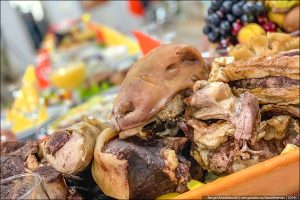




The preference for meat as the main food of the Kazakhs is expressed in a dish – “et”, which contains a harmonious sequence of elements observed in our days: teeparty (shäi ishu), serving of head and meat (bas tartu and et tartu), blessing (bata sūrau), distribution of meat by rank (sybağa), distribution of head meat by rank (basty bölshektep taratu), cutting of meat (etti zhapyraqtau), meal (as zheu), treatment with one’s own hands (asatu), serving sorpa (sorpa taratu), permission to move away from the table (as qaitaru), blessing (dastarkhanğa bata beru), tea party (shäi ishu). The sequence of this unique complex, which encompasses many areas of traditional Kazakh life, is expressed in the charming folk proverb eki shäi – bir et (two teas around one meat).
The first in the chain – tea (tea ceremony), which appeared later, became an integral part of the culture of the Kazakhs. The invitation to tea became a desire to communicate or express sympathy, for example, “könil shäi”, to which it is customary to invite those who have recently lost a loved one. Kazakh tea party has its own characteristics – it is served in the kese (traditional crockery) and filled only halfway. A bowl filled to the brim is considered disrespectful.
Bas tartu is one of the symbolically significant elements of the feeding ceremony. Usually, it is a boiled lamb’s head that is given to the esteemed aksakal – the elder who blesses the communal meal. If it was a women-only meal – “qursaq toi” (a holiday on the occasion of pregnancy) – the head was served to the elder woman. A man whose father was still alive was not served the head, which was considered a bad omen. The offering of the animal head is related to its symbolic meaning as a sacred top.
When processing the meat from the head of a ram, the aksakal must have followed the ritual of distribution. For example, the tongue was given to children with the wish “nimble tongue”, tañdai (palate) to the youngest daughter or singer, tös (breast) to the son-in-law, and if it was not – given to daughters or daughters-in-law, the ear was given to the youngest in the house. It was believed that if the young man ate the bone clean, he would get a beautiful wife. And the radius (käri zhilik) was never served to the girl because it was believed that she could stay with the maids. In Kyrgyz there are interesting references to the ritual of eating meat: the head nourishes the desire to be above everything; the pelvic bone together with part of the kurdyuk the well-being and health; the ribs with the flank the approach to the world, unity; the femur represents the life situation, health; the lumbar vertebrae the resistance to various trials; the liver for brotherhood; the shoulder for suppleness and luck [3, p. 37].
Treating someone personally (with the hand) (asatu) is a sign of special respect. The owner bypassed the guests and personally put a piece of qazy or meat in everyone’s mouth, accompanied by the process of good wishes.
Thus, from the point of view of nonverbal semiotics, a single traditional food “et” represents a whole complex of sign systems. The scientist A.S. Zhilkubayev, who studied secondary naming and semantic transformation of words in Kazakh culture, noted the following symbolic complexes: Qūiryk-Bauyr – the first meaning of ethnographizm “a dish consisting of tail fat and liver”, the additional value – “sign of marriage”; öIi-tiri – first meaning “ram, brought by the bridegroom”, additional value – “obligatory condition of marriage”, sign of worship of the deceased; asyqty zhilik – meat, “tibia”, additional value – “obligatory condition of adoption” [5, p. 113].


